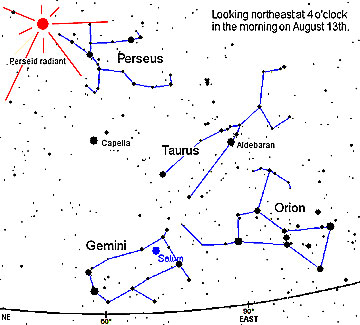"No matter where you live, the best time to look will be just before dawn on Wednesday morning, August 13th," says Bill Cooke of NASA's Space Environments Team at the Marshall Space Flight Center. At that time, the sky overhead will be tilted into the debris stream of Comet Swift-Tuttle--the source of the Perseid meteors. Furthermore, the moon will be low in the sky before dawn. You can stand in the shadow of a building or a hill or some other Moon-baffle to reduce its glare.
“When skies are dark and clear, observers often see as many as one hundred Perseids per hour--an impressive display,” reports the NASA official. "Unfortunately, this year, however, skies won't be dark. A glaring full moon will wipe out many faint meteors and reduce by a factor of two or three the number that will be seen."
Last year in November Cooke led a team of astronomers to study the Leonid meteor storm, which likewise happened during a full moon. "Observers who ducked into the shadows counted twice as many meteors as those who stood in full moonlight," Cooke said.
Another way to minimize the bad effects of the moon is to travel to a site where the air is clear. Even when you face away from the Moon, Cooke explains, the air glows because of moonlight scattered from air molecules and aerosols (e.g., water droplets, dust and pollution). This glow will be less in places where the air is dry and pollution-free. Mountaintops are excellent because they rise above the humid lower atmosphere and most aerosols.
Once you find your observing site and settle in--a comfortable chair and blankets are recommended--there's no special direction you have to face. Perseids can appear anywhere in the sky.
"But don't look toward the Moon," Cooke cautions. "That will ruin your night vision." But, maybe, go ahead and look at it just once, because on August 13th the Moon and Mars will be pleasingly close together, only a few Moon-widths apart. Other than the Moon itself, Mars will be the brightest object in the sky that night--red, piercing, and a joy to see through a telescope. When the Perseid meteor shower peaks, Mars will be only two weeks away from its closest approach to Earth in some 60,000 years!
When you see a Perseid, perhaps even one streaking past Mars, trace its tail backward. It will lead to the constellation Perseus.
"Perseid meteors stream out of a point in Perseus called the radiant," Cooke explains. Because of foreshortening, meteors near the radiant appear short and stubby. Meteors away from the radiant are longer and more eye-catching.
You can see some really long ones on Tuesday evening, August 12th, NASA reports. Called Earthgrazers, they are shooting stars that emerge from the horizon and streak horizontally through the atmosphere. They tend to be slow, bright and colorful.

Pictured is the northeastern sky at 4:00 A.M. on August 13, 2003. NASA reports that meteors will seem to flow from a point in Perseus, called "the radiant" (red dot). Also, look for Saturn in Gemini.






Comments